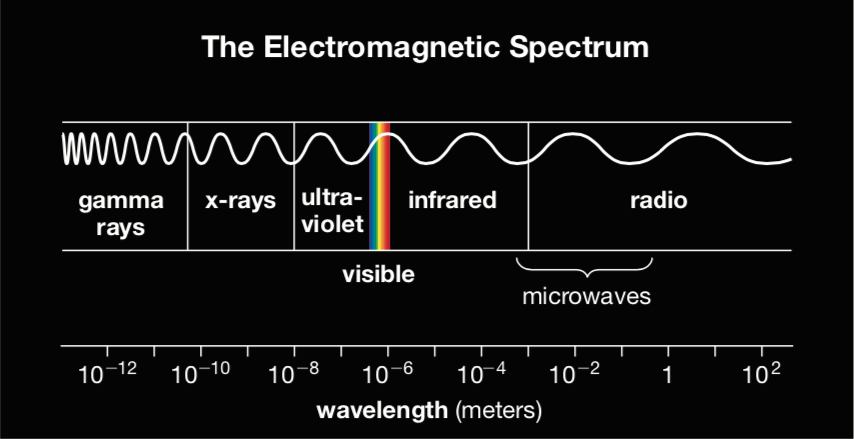The Many Forms of Light
This box is a “Review” because most students will already have learned about the spectrum and the different forms of light in a Physical Science unit (NGSS standard MS-PS4B). However, it will almost certainly be worth spending a little time to review the ideas, and you may have some students for whom this material is new.
You’ve probably learned before that there are many forms of light besides the “visible light” that our eyes can see. To understand the many forms of light, it’s helpful to start by reviewing exactly what light is.
Light is a form of energy that travels through space at the speed of light (about 300,000 kilometers per second) and is characterized by rapidly changing electric and magnetic fields. For this reason, we often say that light is an electromagnetic wave. Like any wave, electromagnetic waves are characterized by a wavelength .
We refer to the full range of wavelengths as the electromagnetic spectrum , and Figure 1 shows the names we give to different sets of wavelength. Let’s start at the rainbow in the middle of Figure 1:
- The light that our eyes can see is called visible light . The rainbow shows how the color that we see depends on wavelength: On the short-wavelength side of the rainbow, visible light is blue or violet. On the long-wavelength side, it is red. Note that visible light represents only a very small part of the full spectrum of light. (Visible light is the narrow rainbow with wavelengths ranging from about 400 to 700 nanometers.)
- Light with wavelengths slightly longer than those of visible light is called infrared light . It gets this name because infra means “further on” or “beyond” and this light is beyond the red end of the visible light spectrum.
- The longest wavelength forms of light (beyond the infrared) are called radio waves , or just “radio” for short. In other words, radio is a form of light, not sound. However, sound signals can be electronically encoded in radio waves, which is why we often talk about “listening to the radio” even though the radio waves themselves are a form of light.
Note that microwaves (like those used in your microwave oven) are an alternative name for the wavelengths in parts of the infrared and radio regions of the spectrum.
- Going in the other direction from visible light (to the left in Figure 1), ultraviolet light lies beyond the violet end of the visible light spectrum, meaning it represents slightly shorter wavelengths than visible light.
- Light with even shorter wavelengths represents what we call x-rays . In other words, the “rays” in x-rays refer to light waves (electromagnetic waves).
- The shortest wavelength forms of light are called gamma rays .

The basic names above (radio waves, infrared light, visible light, ultraviolet light, x-rays, gamma rays) are pretty easy to remember, but there are a few more ideas that you should also keep in mind and that will help you when you hear people talking about light:
- The term radiation is often uses as a synonym for light. For example, you may hear infrared light being called “infrared radiation” or ultraviolet light referred to as “ultraviolet (uv) radiation.” More generally, light is sometimes called “electromagnetic radiation.”
- In addition to a wavelength, waves also have a frequency that describes how many waves pass some point each second. Frequencies are always higher for short wavelengths and lower for long wavelengths, which means that gamma rays and x-rays have very high frequencies and radio waves have very low frequencies.
- When studied carefully, the behavior of light can seem rather strange: Sometimes it behaves like waves, which are spread out over some distance (like ocean waves or waves on a string), and sometimes it behaves like individual particles. For this reason, we often talk about individual “pieces” of light, which we call photons . For example, we might talk about “x-ray photons,” meaning individual x-rays, each characterized by its wavelength (and frequency).
The following video reviews these ideas in a little more detail.